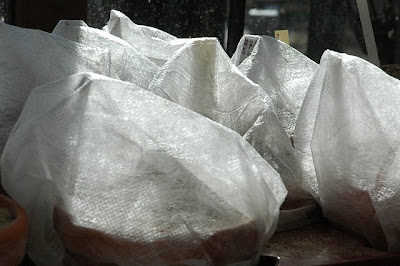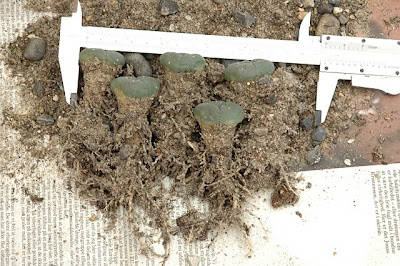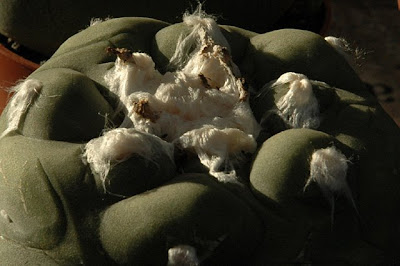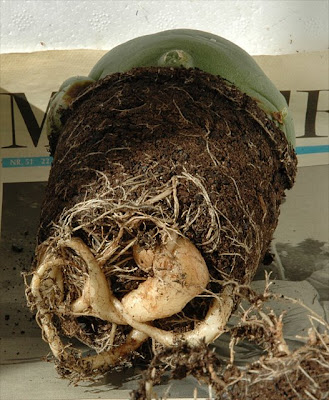As mentioned in the previous post on Ariocarpus and Epithelantha I have experimented with coldhouse grown Lophophora since 2004.
Lophophora williamsii (SB 854; Starr Co, Texas), 2004
The Lophophora williamsii (SB 854; Starr Co, Texas) plants from the 2004 batch are still doing great. The plants are growing true to the type with a glaucous bluish-green epidermis. The one on the left flowered last year so I'll soon be able to produce seeds originating from plants that have survived several seasons in an unheated greenhouse. During winter all my Lophophora plants are wrapped in horticultural fleece - both as a protection against the cold but also to keep out hungry pests.
Lophophora plants wrapped in horticultural fleece
Some of the plants needed to be repotted before the upcoming growing season, for example these Lophophora williamsii (SB 854; Starr Co, Texas) plants from the 2005 batch.
Lophophora williamsii (SB 854; Starr Co, Texas), 2005
The plants started from seed in 2005 have grown to 2.5 - 3 cm (~ 1'') in diameter - with a bit of luck they might flower already this summer.
Uprooted Lophophora williamsii (SB 854; Starr Co, Texas), 2005
I never cease to be marveled by how large a fraction of a Lophophora plant that is actually growing underground. The plant pictured below has a crown that is approximately 1 cm high while the massive part of the taproot amounts to 4 times that and the full root system is more than 10 cm long.
Lophophora williamsii (SB 854; Starr Co, Texas) with exposed root, 2005
The past winter was mild - the coldest temperature registered inside the coldhouse was -5C (23F) - so even my Lophophora diffusa and Lophophora decipiens plants have all survived without any signs of damage. 
Lophophora diffusa (Higuerillas, Queretaro, Mexico)
The Lophophora decipiens plants are very shriveled and look in dire need of a drink of water. They'll have to wait for a couple of more weeks in order for the weather to warm up.
Shriveled Lophophora decipiens
Last year I grafted a handful of Lophophora williamsii (SB 854; Starr Co, Texas) seedlings on frost hardy Opuntia compressa (Monmouth County, New Jersey) stock. The grafts seem to be doing well and I'll get back with more information on Opuntia grafting when I've done some more experiments.
Lophophora williamsii (SB 854; Starr Co, Texas) grafted on Opuntia compressa stock
Sunday, March 30, 2008
Lophophora - experiments in cold hardiness, 2008
Saturday, March 29, 2008
Ariocarpus and Epithelantha - experiments in cold hardiness, 2008
Since 2004 I've experimented with growing Lophophora, Epithelantha, and Acharagma in an unheated greenhouse in Denmark. Last year I also added some Ariocarpus plants to the experiment, both seed grown and larger plants bought from Mesa garden. This winter has (as usual, I'm tempted to say) been damp but not very cold - the coldest temperature registered inside the coldhouse was -5C (23F) so most plants are doing great. 
Ariocarpus fissuratus (JM122; Pecos County, Texas)
Last year I bought a couple of Ariocarpus fissuratus (JM122; Pecos County, Texas) plants from Mesa Garden. Coming out of winter they are still looking good and seem to have coped well with the cold.
The Epithelantha plants pictured below were started from seed in 2004 and look like they are large enough to start flowering soon. 
Epithelantha micromeris v. greggii (Cuesta la Muralla, Coahuila, Mexico)
Apart from Epithelantha micromeris v. gregii I'm also growing the "regular" variety of Epithelantha micromeris. In my experience the regular micromeris is slightly slower growing than the greggii variety.
Epithelantha micromeris (SB1327; near Belen, New Mexico)
All of my Ariocarpus (including last year's seedlings) and Epithelantha plants made it through winter without damage. The next post describes how my Lophophora plants are doing after the winter.
Monday, March 24, 2008
Lophophora bargain
When visiting garden centers and flower shops I'm always checking out their cacti and succulents to see if they have any interesting plants. Usually they don't. This Easter my girlfriend and I were browsing a garden center looking for common hollyhock (Alcea rosea) to plant at our summerhouse when I eyed a trayful of Lophophora plants.
Six large Lophophora plants
The plants are quite large, 7.5 - 8 cm (~ 3'') in diameter, and are looking a bit bloated; they don't have the ancient, mature look and feel you would normally expect from plants this size.
Lophophora 7.5 cm in diameter
Despite their youngish appearance the plants are old enough to be sexually active (many have flower remains peering out of the wool).
Lophophora with flower remains
I don't think the garden center exactly knows what they are selling. The plants are mislabeled as "Lophophera williamsii" and when asked the people at the center had no idea where the plants were produced. Maybe that's why the plants are sold dirt cheap at 35 DKK apiece (approximately 7 USD or 4.5 EUR). Anyway, I ended up buying 9 plants and even though they are allegedly Lophophora williamsii I'm pretty convinced there's at least one L. diffusa among my plants.
Root-bound Lophophora cactus
The plants are extremely root-bound and growing in a peat based soil with (what looks like) blackish lava granules in the mix. After carefully removing the plants from their pots they were left to dry for a couple of days before being repotted.
Four of the plants will probably end up in my coldhouse, and I'm planning to dissect one of the plants to study its anatomy. She who must be obeyed is particularly fond of the last idea - she's already bitching about where to find room for all my new plants ;-)
You can see photos of some of the plants flowering in this post.
All Time Most Popular Posts
-
Lophophora williamsii (peyote) populations have diminished in large areas of South Texas where peyoteros harvest the cactus for ceremonial ...
-
On various occasions I've been asked what growing media I'm using for my cactus plants. I don't have a set soil mix recipe as su...
-
Below is a list of retailers/nurseries selling cactus seed and plants. I've only listed vendors I've done business with. If you ar...
-
Most cacti are easily grown from seed - and with a little patience and care they can be grown into beautiful plants. Lophophora williamsi...
-
In last month’s post on the troubled Texan peyoteros I referred to Anderson’s article on the peyote situation in Texas. Given the importanc...
-
Yet another slightly off topic and probably not entirely politically correct post, but I couldn’t help noticing the similarity of my monstr...
-
Flowering stand of San Pedro cacti (Trichocereus pachanoi) To me the main draw of the San Pedro cactus ( Trichocereus pachanoi (syn. Ech...
-
In the June 2008 issue of the Cactus & Co magazine Jaroslav Šnicer, Jaroslav Bohata, and Vojtěch Myšák described a new Lophophora spec...
-
There seems to be an increased focus on the alarming Texas peyote situation. A couple of weeks ago the Houston Press published a mournful, i...
-
I spent two weeks working in Delhi, India during January. I had one weekend off and had planned to spend it in Delhi at my own leisure, but ...


















